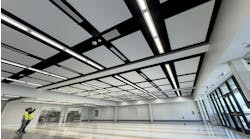Latest from Technology
Sponsored
By Zach Feldmann
As we reach the halfway point in 2020, while many industries continue to suffer, some are seeing a resurgence in both activity and hiring. Leading the pack is the Construction industry which has continued to push forward. Across the US, most states have deemed commercial and residential projects “essential” leading to a significant ramp up in construction activity. The most recent LinkedIn Hiring Report for June shows construction hiring at 75% of levels seen at this time last year.
Over the past several months, I have been fortunate to have had numerous conversations with construction workers to better understand the challenges that they face in the industry. Many contractors feel they must “adapt or die” to new ways of working in order to better connect remote project teams and double down on current construction technology trends that help their businesses conform to a new normal in commercial construction. One long-standing construction trend, that is likely to see even more adoption and growth moving forward, is prefabrication. Prefabrication adoption by medium and large commercial trade contractors has more than tripled in the last 10 years with new digital manufacturing capabilities and the rapid adoption of BIM and 3D modeling. I believe that we will see prefab adoption accelerate in the current COVID environment, and beyond, in an effort to adapt to new regulations and strive for better operational quality, efficiency and reduced costs.
Three key factors that point to why prefabrication will become increasingly essential:
On-site labor restrictions
Prefabrication has always been seen as a way to build more with less and reduce the variability of labor cost for contractors in construction. These efforts are not always viewed in a positive light by those tradesmen who believe this “strips guys in the field of hours”. However, current COVID restrictions are now significantly reducing the number of trade crews that can be present on the same floor of a construction building. One superintendent I spoke with said,
“The biggest challenge we are seeing, as projects ramp back up, is the reduction of manpower on site… Contractors are going to have to find ways to do more work off the construction site in a safer and more easily managed environment”
Supply chain disruptions
A recent survey by the Association of General Contractors (AGC) reported that, as of June 1st , 38 % of subcontractors are experiencing at least some material delay or cancellations as a result of the COVID pandemic. Ordering material to construction sites, where there are fewer workers to receive or inspect deliveries, may not be the best course of action for trade subcontractors, who have to order material several weeks or months in advance. Instead, connecting the delivery of construction materials and vendor equipment to arrive first at prefabrication shops would allow contractors more resources to manage those deliveries. In addition to an ability to prefabricate different raw materials, before it arrives on site, to increase quality controls for installations on the job site.
Just-in-time (JIT) delivery
With reduced manpower on the job site, delivery schedules are transforming into mandatory windows for work and material installation. Speaking with a large Bay Area prefabrication manager, I learned a lot about how an increased focus on prefabrication allows his team to align packaged deliveries to arrive when field crews are ready for installation in the field.
“With more narrow time slots for piping or ductwork installation, we need to be able to build in a more repeatable and controlled way that coordinates more tightly with those crews in the field. Prefabrication offers a strong solution to this immediate challenge”
Many of the contractors I’ve spoken with are looking to implement new operational practices for prefabrication. Leveraging everything from lean construction methodology to adopting new digital workflow solutions. In my opinion, those who want to bring new ways of working and technology into construction need to understand the changing business environment and project-to-project existence many contractors work in today. Startups and large technology companies alike must leverage different business models and strategies to reduce friction to the adoption of new solutions for prefabrication and construction. I believe those who wish to change the construction industry must first and foremost serve tradespeople and contractors to better understand their world. We exist not to give our contractor partners “one more app” or challenge institutional construction knowledge. Rather we must build solutions that integrate critical project information and enable current building methods to increase productivity and improve transparency.
If you’re interested in learning more about what we’re working on (such as the OneConstruct platform to connect schedules, documents and fabrication statuses) or want to partner alongside us, feel free to reach out to us at www.stanleyx.com . If you’re interested in helping move this industry forward with innovation, apply to be part of our Construction Tech Advisory Board. Apply here.
Since joining the company in 2017, Zach Feldmann has directed new product introduction, pricing, and go-to-market strategies across Stanley Black & Decker. Focused in bringing deeper insight and improved productivity to the construction industry, he is a founding member of the Stanley X startup accelerator, providing industry insight and strategic direction for construction startups and technology companies. At the University of Maryland’s Robert H. Smith School of Business, Zach earned a dual MBA/MS in Data Science and Statistics.


